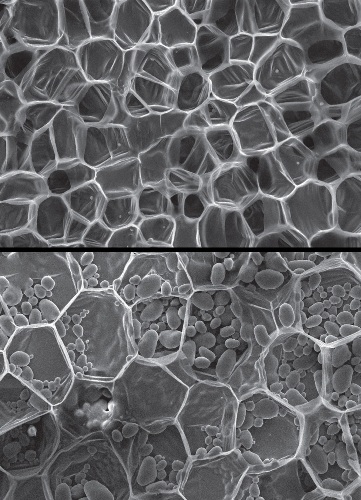Compiling and analyzing information on the microstructures of a variety of plants, Lorna Gibson, a researcher at the Massachusetts Institute of Technology, has discovered that plants demonstrate a broad range of mechanical properties based on the arrangement of four key building blocks of a cell wall, namely pectin, lignin, hemicelluloses and cellulose.
 A scanning electron micrograph of carrot, top, and potato, bottom, showing relatively thin-walled cells. The oval objects within the potato tissue are starch granules. (images: Don Galler)
A scanning electron micrograph of carrot, top, and potato, bottom, showing relatively thin-walled cells. The oval objects within the potato tissue are starch granules. (images: Don Galler)
Gibson stated that knowledge on the microscopic organization of plants will be helpful in designing novel bio-inspired materials. Gibson’s findings have appeared in the Journal of the Royal Society Interface. According to Gibson, the components of a cell wall are analogous to certain synthetic materials. For instance, lignin, hemicelluloses, and cellulose exhibit stiffness and strength as manmade polymers. The arrangement of cells in a plant can also have engineering resemblances. For example, cells in woods are arranged like engineering honeycombs and polyhedral cell patterns present in apples are like certain industrial foams.
To study natural mechanics of plants, Gibson concentrated on three key plant materials, arborescent palm stems like coconut trees; parenchyma cells that are present in root vegetables and fruits; and woods like oak and cedar. She collected and analyzed data of her own and from other team’s experiments to study two key mechanical properties in each plant, namely strength and stiffness. She noticed large range in both properties. Vegetables and fruits like potatoes and apples demonstrated least stiffness, while the densest palms exhibited 100,000 folds higher stiffness. Similarly, potatoes and apples demonstrated the least strength, while palms showed 1,000 folds higher strength.
The wide variety in strength and stiffness is due a complex combination of plant microstructures, including the count of layers in the cell wall, the cell wall composition and the alignment of cellulose fibers in these layers, and the amount of space occupied by the cell wall. Gibson believes that plant mechanics is a valuable resource for researchers to design innovative materials. For instance, scientists are not able to synthesize cellular composite materials with the degree of control perfected by plants. The microstructures developed by plants are there to meet all their requirements. With the advancement in nanotechnology, it is possible to design multipurpose engineering materials instigated by plant microstructures.